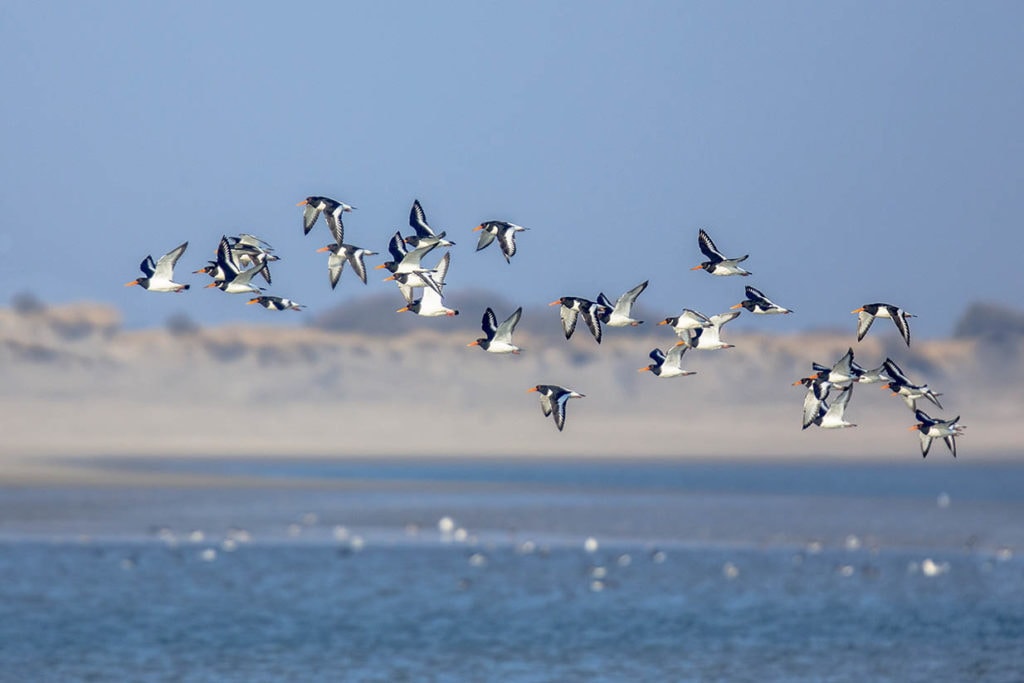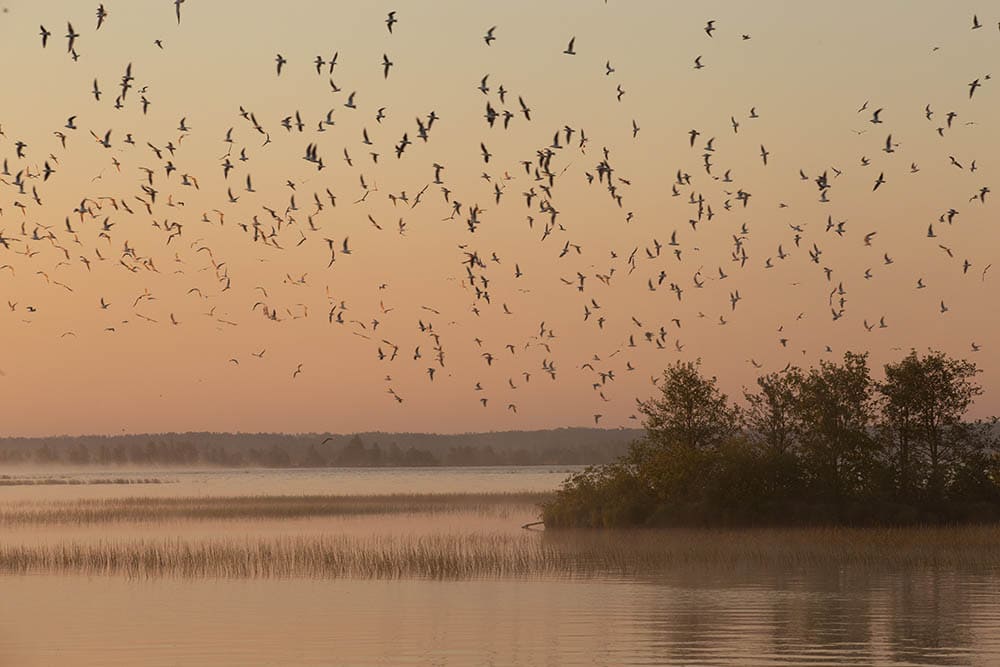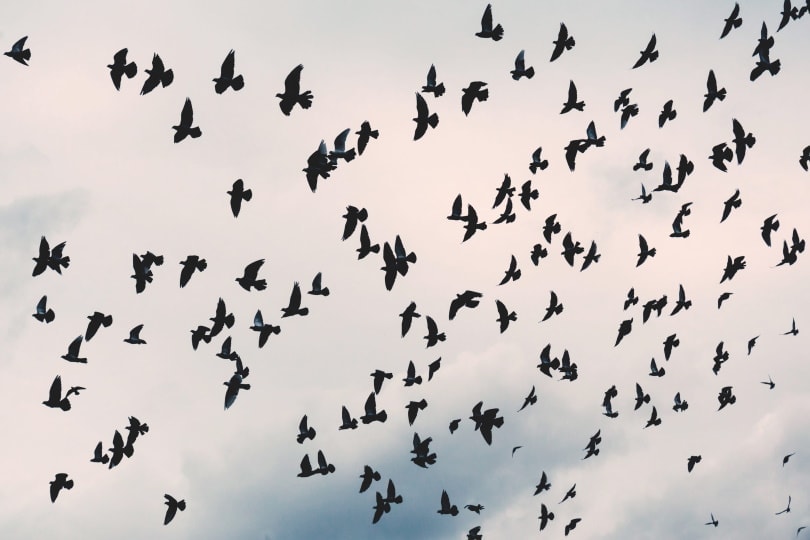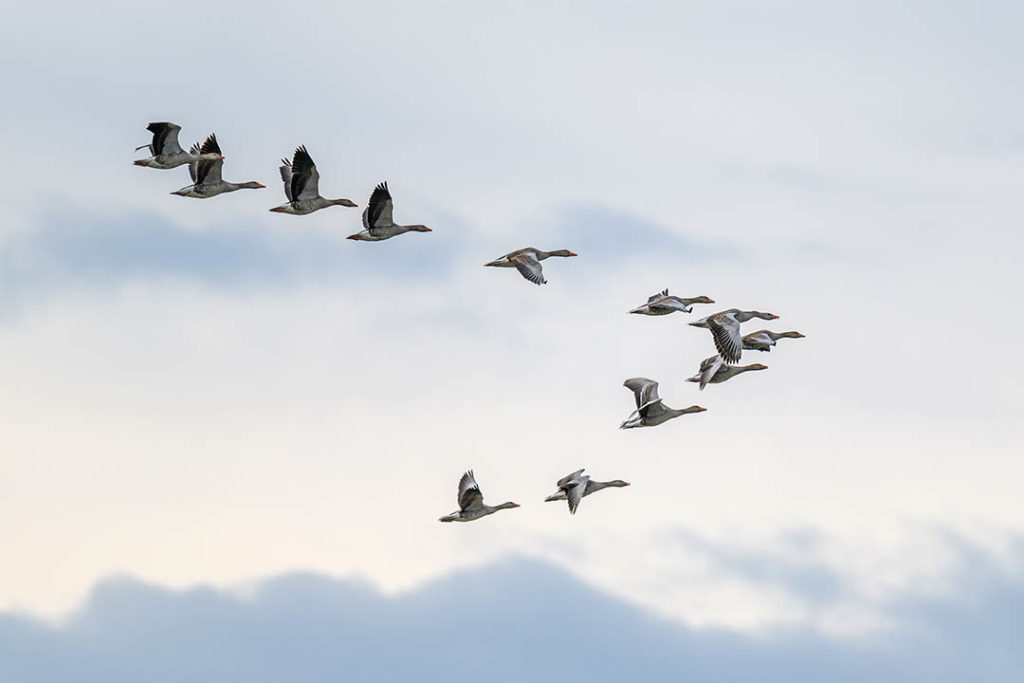Why Do Birds Fly in Huge Flocks? The Interesting Answer!
Last Updated on

One of the most beautiful sites to behold is a large flock of birds moving in unison across the sky. When we see these intriguing visions, our inquisitive minds immediately begin to wonder why? Why do birds fly in huge flocks? How are they able to move in such coordinated unison? Honestly, there are several reasons this takes place. To help people understand the movement of these amazing creatures, let’s take a look at a few of the reasons birds flock together and how it’s beneficial to their survival.

Understanding the Flock
Before we look at why birds fly in a flock, let’s try to better understand what a flock is. You can’t necessarily call a random group of birds that find themselves near each other a flock. A flock is formed when birds of similar size and shape, often the same species, come together to live and work as one. You may think a flock consists of the same types of birds, but this isn’t always the case. A flock can consist of more than one bird species, but having more than two species living together is rare. Normally, it is the differences in behaviors that bring mixed flocks together.
In most flocks, there are two distinct members, sallies and gleaners. Sallies act as the flock’s guards and eat their food while they are in flight. Gleaners prefer vegetation as their main source of food. The reason these two work well in a mixed flock is that gleaners often send insects and other morsels fleeing from the vegetation they eat, which provides the sallies of the flock extra sustenance. This balance works well and is one of the reasons a mixed flock can be so prosperous.

Safety in Numbers
We may hear the term safety in numbers pretty often, but when it comes to flocks of birds, it’s true. One of the main reasons birds fly together in a huge flock is to better protect themselves from predators. When the birds are together, there are more eyes to spot potential dangers. This includes predators, humans, and obstacles.
When a flock senses danger, they immediately come together to help protect one another. Groups of birds practice mobbing. Mobbing is when birds chase or attack a predator in hopes of driving it away and keeping the flock safe. It is also to every bird in the flock’s advantage to stay in a larger group. If an attack does take place, there are more potential targets that lower the risk to one solitary bird.
Fast Food
Another reason birds enjoy flocking in large groups is faster food options. Whether the birds are in the air or swooping down to the ground, the more in the flock, the better resources they can spot. One bird in a flock can indicate to the others where the food is and lead the flock in for the foraging they need. When the birds decide to eat, some in the flock will lose prey. If this happens, another in the flock will benefit by grabbing the prey and finishing it off.
Unfortunately, foraging together can have its downsides. Often, the more dominant birds in the flock will reap the benefits of the flock hunting methods while others are left to do without or pick up the leftovers. Another issue with flock foraging is that certain birds may become lazy with their hunting habits. These birds don’t alert the others when food is found and instead wait for the other members of the flock to do the job for them.

Raising Families
When a flock of birds isn’t in the air, they are nesting. By doing this in a group, the young are better protected. Not every bird that flocks together decides to nest together, but those that do have the advantage of having other adult birds to help look after their nests or young when needed. This peace of mind makes nesting easier for many bird species and helps them ensure their young are ready to join the flock when they take flight again.
Warmth for the Winter
While most flocks spend their time migrating, when the winter months come, they need to rest and warm themselves from time to time. If birds are part of a flock, finding this warmth is easier. The birds in a flock often gather together to roost in trees or other easy-to-access areas. This helps all birds, including the younger members, beat the winter cold and prepare for the rest of their flight.

What About the Flying V?
We’ve all seen or heard of birds flying in a V shape. You may think only ducks use this pattern when they fly, but that isn’t the case. Other birds who fly in flocks use the flying V or other shapes to take advantage of wind currents or change them to their needs. Using these shapes is energy-efficient for the flocks. They can fly for longer distances, without a lot of rest, when they take shape and use these strategies to their advantage.
Conclusion
As you can see, the concept of birds flying in huge flocks has several advantages. The next time you see a beautiful flock of birds, stop and take in the intricacies you’re witnessing. Every member of that flock is helping the one next to them. Together, they are more successful, stronger, and faster than a solitary bird taking on the world alone.
Featured Image Credit: Rudmer Zwerver, Shutterstock
About the Author Robert Sparks
Robert’s obsession with all things optical started early in life, when his optician father would bring home prototypes for Robert to play with. Nowadays, Robert is dedicated to helping others find the right optics for their needs. His hobbies include astronomy, astrophysics, and model building. Originally from Newark, NJ, he resides in Santa Fe, New Mexico, where the nighttime skies are filled with glittering stars.
Related Articles:
10 Types of Hummingbirds in Arkansas (With Pictures)
8 Types of Hummingbirds in Nebraska (With Pictures)
5 Types of Hummingbirds in Idaho (With Pictures)
3 Types of Hummingbirds in Mississippi (With Pictures)
8 Types of Hummingbirds in Kansas (With Pictures)
5 Types of Hummingbirds in West Virginia (With Pictures)
5 Types of Hummingbirds in Ohio (With Pictures)
Where Do Nuthatches Nest? Nuthatch Nesting Habits Explained
